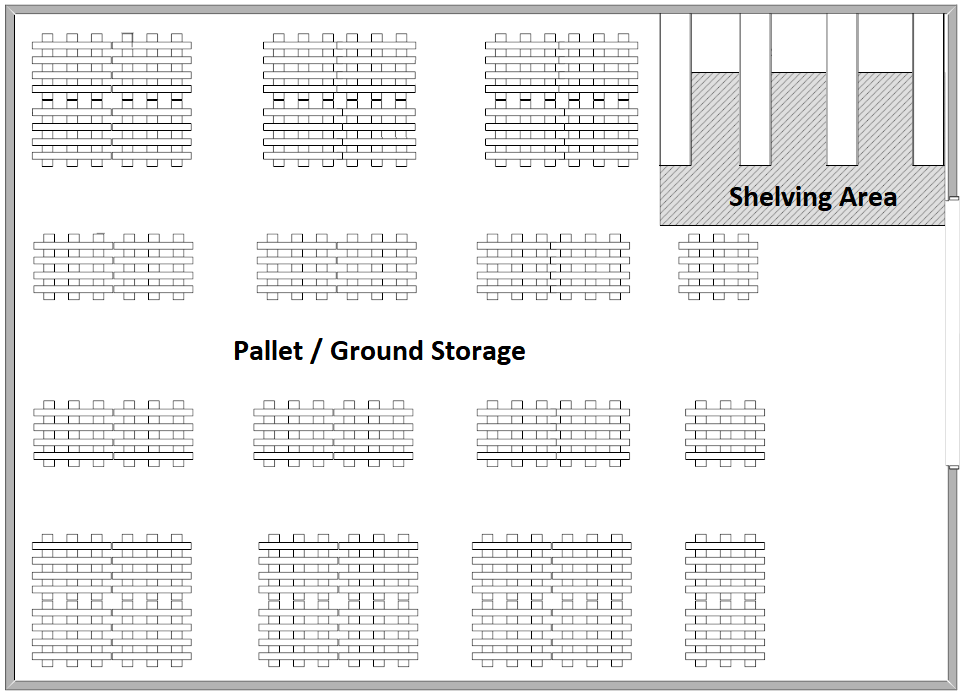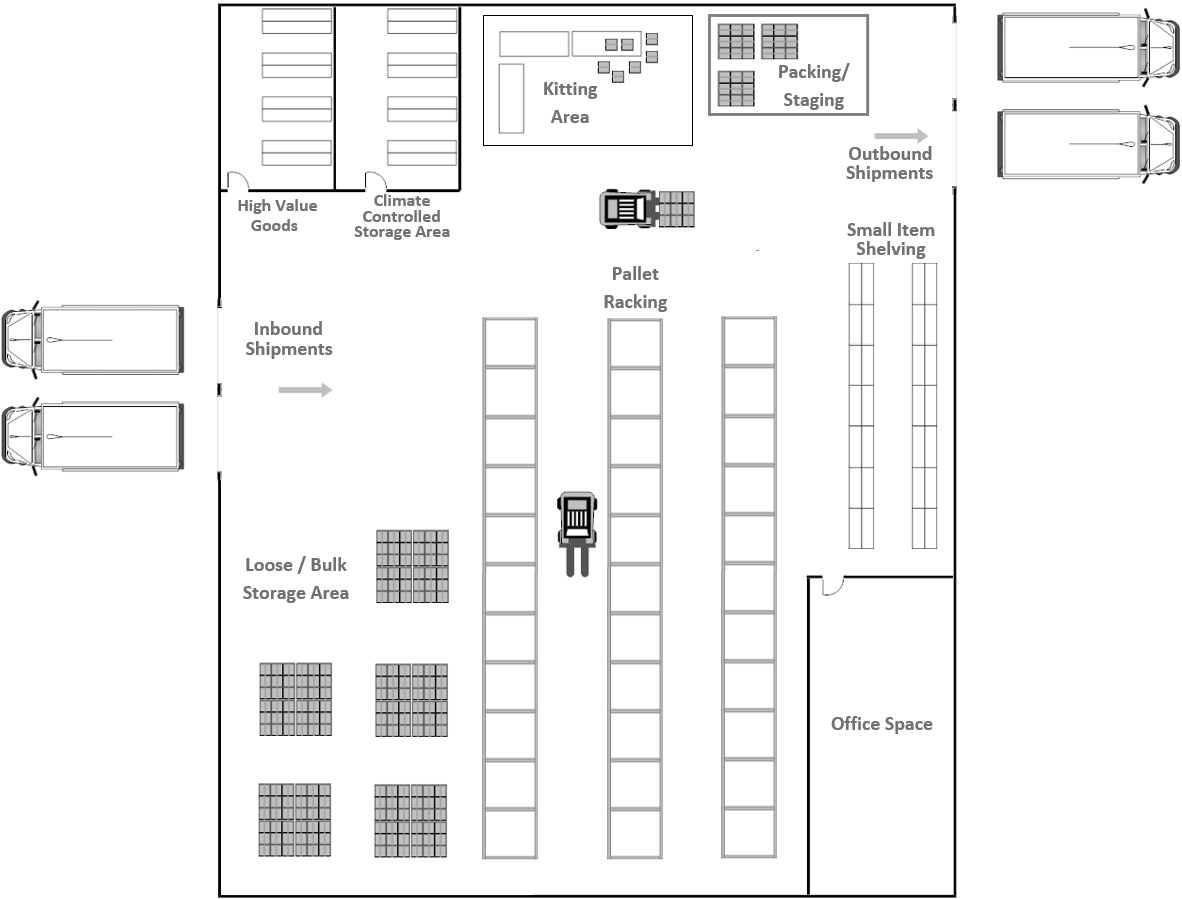Once a warehouse or storage location has been selected meeting the needs of the humanitarian organisation, and the overall response plan, and the facility has been fully restored or renovated to match the storage requirements, agencies will have the opportunity to design the physical layout of the warehouse space and any associated MHE or storage aids. It is important to understand the basics of a warehouse layout upfront to avoid problems later.
Physical Warehouse Layout
A proper warehouse layout should not impede the physical flow of work, increase the risk of damage to items, or impact physical safety of any persons in or around the warehouse.
Warehouses ideally follow the 70/30 rule – around 70% of the floor space of a warehouse will typically be used for storage of physical cargo, while around 30% will be open space for movement and work. The percentages are of used floor space are only guidelines, and space utilisation can be slightly more as needed. A warehouse should never be so full that cargo cannot be accessed, or persons cannot walk around safely inside. All cargo storage should be clearly visible and easy to navigate, and any person in a warehouse should be able to quickly identify locations of items and conduct piece counts with minimum effort.
Warehouses are usually arranged in easy to navigate grid like patterns, with “lanes,” “aisles,” and “rows” - open spaces between racks, rows and stacks of items that enable the free flow of people cargo and MHE. The width of aisles and rows depends on context; lanes in small storage facilities utilising ground stacking and no MHE should be .5 – 1 meter wide to enable access to human movement, while lanes in a large warehouse with racking may be up to 4-5 meters wide to enable access to forklifts or hand trucks. Lanes and aisles should be free from debris or cargo that could block the movement of people or handling equipment. There should be what is known as a “fire lane” – a free and open space between cargo and walls of a suggested 40 cm or the safest available space through which an adult human can move to enable quick exit. Exits in a warehouse should never blocked, and in large commercial facilities exits should be clearly marked.
Cargo must never be pushed up against walls or touching ceilings. In addition to making accessing cargo difficult, stored items touching the sides of structures runs a greater risk of mould or water damage, and cargo touching the ceiling can be an indication of cargo stored at unsafe heights. It is also advisable to keep a space at the loading/offloading areas of the warehouse to facilitate handling of cargo as it comes into/exits the facility. The size of the open space near loading areas depends on the size of the warehouse and anticipated activities – small facilities may only need a few square meters to manage sorting, while large facilities may need whole kitting arrangements.
For smaller remote warehouses or mobile storage units (MSUs) - Small field warehouses are likely going to be stocked and managed completely by hand. Proper layout can help ease the hand management process. Heavy or bulky items may be stored closer to exits of storage units to minimise efforts to manually move, while frequently used items should be moved closer to the front of the storage site to minimise distance required for porters to manually load/offload.
Example small field storage facility with ground stacking:

Larger Built-up Warehouses – Larger, more built up warehouses and storage facilities have a variety of layout and space management options. The overall need for the various components of a warehouse are dependent on the needs of the agency and the physical features of the available space. Some of the things aid agencies may wish to consider when looking at larger warehouses might include:
- Kitting areas identified and clearly demarcated. Kitting can occur inside the facility or outside the facility, depending on weather and available space.
- (Potentially) offloading and loading will occur in a different loading bays to facilitate the flow of cargo.
- Clearly defined staging areas for consolidation, loading and offloading.
- Climate controlled and other lockable facilities built or converted inside the warehouse, out of the way of the main warehouse flow.
- If any racking, shelving and bulk storage configurations are used at the same time, they are separated in clearly demarcated areas.
- If handling equipment such as forklifts are used, there are clearly defined areas where the forklift drives, ideally marked on the ground in visible paint or tape.
- Pre-defined parking and storage spaces for MHE. If MHE is using electricity, parking spots can also be charging locations.
- Use of drive up loading bays. Bays should be kept free from debris. Recessed bays prevented from flooding with proper drainage, and ramps must be adequate to fit and hold trucks.
- Roll up or swinging doors big enough to accommodate any handing equipment or cargo size.
Example warehouse floor plan of a larger warehouse operation:

Zonal Storage
Irrespective of the structure type or the size, space planners should consider planning the physical location of stored items relative to the amount of effort required to move or load them, including:
- Their size / weight
- Their frequency of usage
SKUs that have the highest volume of turn over - meaning the highest numbers of in and outs - should be stored closer to the cargo loading points of the warehouse or storage facility. The time and effort saved when moving these items between storage location and points of loading/unloading will have long term impacts on the overall timeliness of operations. Inversely, less frequently used items should be stored further away from the storage facility points of loading.
An exception to storing infrequently used cargo in the rear of a facility is planning on storing extremely heavy or difficult to move items near the front of a warehouse or storage facility, even if they are used only rarely. Items like machine parts or generators might be cumbersome or even dangerous to move around inside of a storage site, and keeping them closest to the exit is an advisable strategy. This is especially true for storage locations that are entirely managed by hand - planners should think of the physical capabilities and safety of loaders.


